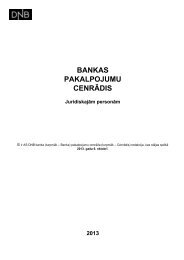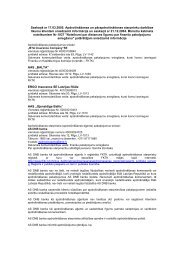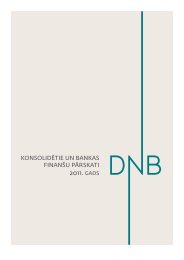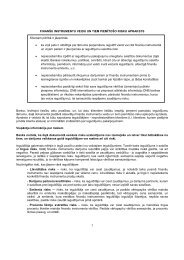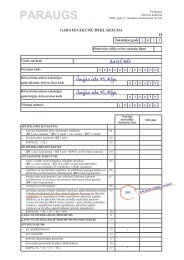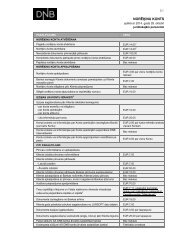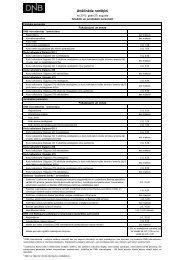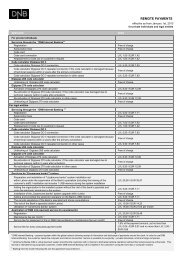Base Prospectus - Malta Financial Services Authority
Base Prospectus - Malta Financial Services Authority
Base Prospectus - Malta Financial Services Authority
Create successful ePaper yourself
Turn your PDF publications into a flip-book with our unique Google optimized e-Paper software.
Final Terms. Prospective purchasers are advised to consult their tax advisers as to the proper<br />
treatment of such Notes.<br />
Further Notes<br />
A U.S. Holder must recognise OID on Further Notes (as defined in Condition 17 of the Notes)<br />
issued at a discount unless the Further Notes are part of the same issue as the original Notes for<br />
U.S. federal income tax purposes. Further Notes will be part of the same issue for U.S. federal<br />
income tax purposes if (i) they are issued within six months of the original Notes when the yield on<br />
the original Notes is no more than 110 per cent. of their original yield or (ii) they are issued at a<br />
de minimis discount from par. A discount is de minimis if it is less than 0.25 per cent. multiplied by<br />
the number of complete years remaining to the maturity of the Further Notes. A U.S. Holder must<br />
accrue OID into income at a constant yield to maturity whether or not it receives cash payments<br />
on the Notes.<br />
Further Notes that are part of the same issue as the original Notes may have market<br />
discount or acquisition premium. Further Notes will have market discount if the holder purchases<br />
them at a discount from par at least equal to 0.25 per cent. multiplied by the number of complete<br />
years remaining to maturity. Further Notes will have acquisition premium if the holder purchases<br />
them for more than par. If a U.S. Holder acquires Further Notes at a market discount, the holder’s<br />
deductions for certain interest on debt incurred or continued to purchase or carry the Notes may<br />
be deferred and partial principal repayments or gain on disposition of the Notes will be ordinary<br />
income to the extent of accrued market discount. A holder may avoid those consequences by<br />
electing to take market discount into income as it accrues. If a U.S. Holder acquires Further Notes<br />
with acquisition premium, the holder may elect to reduce the amount of interest recognised on the<br />
Notes each year by the premium allocable to the year. Elections to accrue market discount and to<br />
amortise acquisition premium generally will apply to all of the holder’s Notes that have market<br />
discount or acquisition premium.<br />
Sale, Exchange and Retirement of Notes<br />
Upon the sale, exchange, retirement or other taxable disposition of a Note, a U.S. Holder<br />
generally will recognise capital gain or loss equal to the difference between the amount realised<br />
upon the sale, exchange, retirement or other taxable disposition (less any amount attributable to<br />
accrued interest, which will be taxed as such) and the adjusted tax basis of the Note. A U.S.<br />
Holder’s tax basis in the Note will, in general, be the U.S. Holder’s cost therefor, decreased by any<br />
amortised bond premium and by any payments received on the Note other than qualified stated<br />
interest and increased by any OID previously included in income by the U.S. Holder. For purposes<br />
of the U.S. foreign tax credit limitations, capital gain realised with respect to a Note generally will<br />
be treated as U.S. source gain, although a loss realised with respect to a Note may be treated as<br />
a foreign source loss. In the case of a U.S. Holder that is an individual, estate or trust, the<br />
maximum marginal federal income tax rate applicable to such capital gain is currently lower than<br />
the maximum marginal federal income tax rate applicable to ordinary income if the Notes are held<br />
for more than one year. The deductibility of capital losses is subject to limitations.<br />
Gain or loss realised upon the sale, exchange, retirement or other taxable disposition of a<br />
Non-U.S. Dollar Note which is attributable to fluctuations in currency exchange rates will be treated<br />
as ordinary income or loss. Gain or loss attributable to fluctuations in exchange rates will be<br />
calculated by multiplying the original purchase price paid by the U.S. Holder (expressed in the<br />
relevant foreign currency) by the change in the relevant exchange rate (expressed in dollars per<br />
unit of the relevant foreign currency) between the date on which the U.S. Holder acquired the Non-<br />
U.S. Dollar Note (or, in the case of Notes traded on an established securities market, as defined in<br />
the applicable Treasury Regulations, that are purchased by a cash basis U.S. Holder, or an<br />
accrual basis U.S. Holder that so elects, on the settlement date for the purchase) and the date on<br />
which the U.S. Holder received payment in respect of the sale, exchange, retirement or other<br />
taxable disposition of the Non-U.S. Dollar Note (or, in the case of Notes traded on an established<br />
securities market, as defined in the applicable Treasury Regulations, that are purchased by a cash<br />
basis U.S. Holder, or an accrual basis U.S. Holder that so elects, on the settlement date for the<br />
sale). Such foreign currency gain or loss will be recognised only to the extent of the total gain or<br />
loss realised by a U.S. Holder on the sale, exchange, retirement or other taxable disposition of the<br />
Non-U.S. Dollar Note.<br />
88



